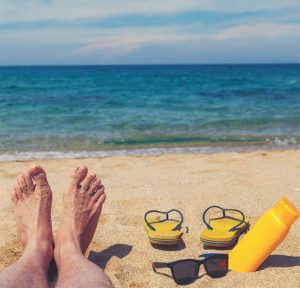By Premier Foot & Ankle Specialists
 Here in Florida we live near beaches and warm sunny weather all year around but our feet are vulnerable to these luxuries.
Here in Florida we live near beaches and warm sunny weather all year around but our feet are vulnerable to these luxuries.
Walking barefoot in the sand at the beach or by the pool can be dangerous, especially for diabetics. Below are some ways to protect your feet and prevent foot problems.
1. Wear shoes with socks and limit walking barefoot. Without shoes, your feet are exposed hot sand and surfaces, the suns UV rays and organisms that can cause athlete’s foot, toenail fungus, ring worm or bacterial infections. In the pool and ocean make sure to wear water shoes to safeguard your feet from the rough cement, shells, coral and rocks. Make sure your shoes dry out completely before using again to prevent bacteria and fungus from growing in them. You can periodically wash your shoes in the washing machine and line dry them to keep them clean. Try to avoid flip flops as they put your foot in an unneutral position causing progressive deformities like bunions, hammertoes and arthritis. If you must wear a flip flop or sandal, look for one with a rigid sole and good arch support like Birkenstocks or Olukais. The best shoe for foot health is a stiff soled lace sneaker with a medical grade orthotic from your podiatrist.
2. Apply sunscreen all over your feet, including the tops and between the toes. It is recommended to use an SPF of at least 30 and reapply every 2 hours. Sun exposure increases your risk for skin cancer of the feet and legs. The most common types of skin cancer of the lower extremity are basal cell carcinoma, squamous cell carcinoma and melanoma. These can occur on the skin or under the nail bed. Some signs of skin cancer on the lower extremity area dark areas under the nail, lesions on the skin that are varied in color, crusty and/ or bleed. These signs are reasons to see your podiatrist immediately for evaluation and possible biopsy.
3. Exercise and drink plenty of water. Drinking plenty of water will help your overall health and also help minimize foot swelling caused by the heat. Exercise with muscle contraction also helps the veins in your legs push blood back up to your heart, further decreasing swelling. Walking is the best way to achieve muscle contraction in your lower extremity.
4. Clean and dry your feet well. Wash your feet daily, especially between your toes with a wash cloth. You can you mild soap or an antifungal shampoo to wash your feet. After washing, make sure to dry well between each toe. Moisture attracts bacteria and fungus and can cause many problems. Using socks and mesh shoes will also keep your feet dry.
5. Moisturize dry skin. Using lotions or oils can help combat dry skin. Avoid placing these between your toes to prevent moisture there. Again, avoiding flip flops and using socks and laced up sneakers will prevent dry cracked heels. Also, stay away from pumice stones which trap bacteria and fungus in them.
6. Watch for problems. You will want to inspect your feet daily for any signs of trouble. Check for signs of ingrowing toenails, cuts or scrapes before going into the water. Catching a problem early and prevent it from getting much worse. Many people only contact a podiatrist when something is broken or sprained but your podiatrist can evaluate and treat many other lower extremity aliments. Everyone should be conscious of their foot health but this is especially true for diabetics. If you find yourself needing a podiatrist, do not wait, call us immediately!
This summer, Premier Foot & Ankle Specialists are ready to help you put your best foot forward, call us today at 941-488-0222!
Dr. Brielle Roggow
Dr. Brielle Roggow was born and raised in Jackson, Minnesota. She attended and graduated from Minnesota State University, Mankato, with a Bachelor of Science in biology. Next, she moved to Cleveland, Ohio where she attended Kent State University of Podiatric Medicine and graduated in the top 10% of her class. Following medical school, she moved to Tampa, Florida where she completed her surgical residency with the James A. Haley Veterans Hospital.
Dr. Roggow is excited to provide exceptional foot and ankle care to Southwest Florida. Her podiatric interests include reconstructive surgery, wound care, trauma, and day-to-day podiatric care. Dr. Roggow enjoys spending her free time with her family. She is married to her husband Joshua and has a son, Jett, a daughter Josie, and two stepdaughters, Rylee and Reese. She enjoys being outdoors on the water, cooking, gardening, and riding horses.
Dr. Jeremy Bonjorno
Dr. Jeremy Bonjorno was born in Dansville, New York. He graduated from University of South Florida with a Bachelor of Science in Biomedical Sciences. Dr. Bonjorno received a Doctorate of Podiatric Medicine from Kent State University in Ohio. He completed a three-year surgical residency at the James A. Haley Veteran’s Hospital in Tampa, where he served America’s veterans.
Dr. Bonjorno is a community-focused podiatrist with a commitment to high-quality patient care. His podiatric interests include diabetic foot care, wound care, bunions, hammertoes, neuromas, and plantar fasciitis. In his free time, he enjoys spending time with his friends and family in Tampa. He also likes music, cars, traveling, and cycling.
Premier Foot and Ankle
(941) 488-0222
premierfootandanklefl.com
4120 Woodmere Park Blvd, Suite 5, Venice, FL 34293








